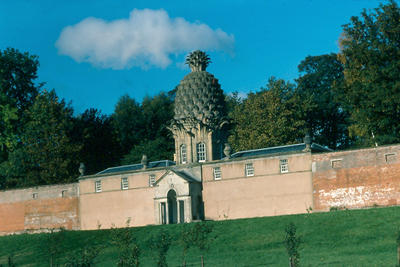Sites and Monument Record: Pineapple gardens (SMR 1407)
Description
Location, setting and extent
The Pineapple was built as a garden retreat in the north wall of the walled garden at Dunmore Park (q.v.). It is approximately 7 km (8 miles) from Stirling and about 1.5 km north of Airth village. It was designed to have extensive views out and particularly across the Firth of Forth but is sheltered and screened by woodland today.
The ornamental gardens extend around The Pineapple over some 4 ha (10 acres), including the walled garden. The walled garden is surrounded by woodland and shrubbery, with a small loch to the west of the walls feeding into the canal.
Components of the designed landscape
Architectural Features
The Pineapple is listed category A; the designer is unknown. It is a two-storey building with a circular chamber facing the garden, capped by a Pineapple shaped in stonework. It is 15m high on its south side and 12m high from the north. The walls of the garden are also listed A, and are of Scottish design, with a double flued wall to enable heating. The chimneys are disguised by ornamental vases. There were glasshouses along the north wall, but these have now gone. The 1st edition map of 1863 shows that a sundial was placed in the middle of the west section of the garden, and a broken sundial remains on site, in front of the Garden Cottage to the west of the garden.
Shrubbery
The area to the north of the walled garden was planted as a shrubbery, and species of yew, ash and rhododendron remain today, but all are overgrown and have obscured the views out to the north and east.
Walled Garden
This is a large walled garden which was divided into two main sections. The larger western section was subdivided into ten compartments possibly partly by hedges, and in the southern compartment is an ornamental pond or canal fed from a small loch to the west of the garden by the garden cottage. Both these water features are silted and overgrown today. The eastern section of the garden was shown in the 1863 map as an orchard; it is divided into two compartments, the southern end has now been planted with trees. The east wall of the west garden is in need of restoration.
See full details
Object detail
The Pineapple was built in 1761 for the 4th Earl of Dunmore as a folly and garden retreat; it forms the central pavilion feature of the north garden wall. The first pineapples grown in Scotland were introduced by James Justice at Crichton near Pathhead in Midlothian c.1732. The portico is dated 1761; however, evidence uncovered during the building's repair in the early 1970s suggests a slightly later imposition of the Pineapple on the portico. Early photographs show the folly closely flanked by glasshouses on both sides. By 1970 after the break-up of the Dunmore estate, the building and garden were in a derelict condition. They were purchased by the Earl and Countess of Perth and gifted to The National Trust for Scotland in 1974. The Pineapple itself has been restored by The Landmark Trust with grants from the Historic Buildings Council and the Scottish Tourist Board and is now in use for holiday lets. The walled garden is being restored by the National Trust for Scotland.
The west garden has been grassed over and planted in a formal pattern as an orchard. The canal could be cleaned out and cleared of its overgrowth to provide an attractive water feature. The shrubbery to the west and north of the house is similarly overgrown and would benefit from scrub clearance, reopening of the woodland paths and the planting of more interesting shrub species. Vistas could be cleared to create views from the Pineapple to the Tower and the Firth to the north, and to open the views south across the canal. The small loch to the west of the walled garden could also be cleared and treated as a water feature. The east wall of the west garden, and the east garden, need restoration.


Public comments
Be the first to comment on this object record.